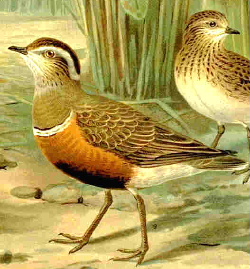|
| 질의: Small white | 결과: 359번째/2237 | |
Eurasian Dotterel (Charadrius morinellus) - Wiki
| 제목: | Eurasian Dotterel (Charadrius morinellus) - Wiki
| |

| 해상도: 250x269
파일크기: 51639 Bytes
촬영일: : : : :
사진기: Exif Viewer Ver.1.1 (FUJIFILM)
등록시간: 2007:10:01 23:02:01
|
Eurasian Dotterel
From Wikipedia, the free encyclopedia
[Photo] Dotterel from old German enc. 1905 date, so public domain
The Eurasian Dotterel (Charadrius morinellus), or in Europe just Dotterel, is a small wader in the plover family of birds.
It breeds in the arctic tundra of northern Eurasia from Norway to eastern Siberia, and on suitable mountain plateaus such as the Scottish highlands and the Alps. It nests in a bare ground scrape and lays two to four eggs.
This species is migratory, wintering in a narrow belt across north Africa from Morocco eastwards to Iran. Migration stopovers are traditional, and small parties (trips) of Dotterels pass through each year at these usually inland arable or grassy sites. The winter habitat is semi-desert.
This plover is smaller and more compact than Eurasian Golden Plover. It has a striking whitish supercilium in all plumages, and has plain wings in flight. Adults in summer are unmistakable, with a chestnut breast bordered above with white, black belly and warm brown back. The legs are yellow and the short bill black. As with the phalaropes, the female is brighter than the male, the latter being responsible for incubation.
Winter birds lack the rich underpart coloration, apart from the white breast line, and are greyer above. Young birds are similar, but have a scaly appearance to their backs.
The Dotterel's food is insects and other small invertebrates such as snails and worms and shellfish. These are obtained by a run-and-pause technique, rather than the steady probing of some other wader groups.
The flight call is a soft pyurr. The female's song is a simple repetitive whistle.
The Eurasian Dotterel is one of the species to which the Agreement on the Conservation of African-Eurasian Migratory Waterbirds (AEWA) applies.
Observations on the Dotterel
The Dotterel has long been considered tame and unsuspecting. This led to it being easy prey for illegal collection of the bird, which depleted its stocks.
Another consequence of the friendly and trusting nature of this bird has caused the name 'dotterel' in English to carry a negative connotation. The term 'dotterel' is a contemptuous label used to describe somebody who is considered to be a doting old fool.
http://en.wikipedia.org/wiki/Eurasian_Dotterel
| The text in this page is based on the copyrighted Wikipedia article shown in above URL. It is used under the GNU Free Documentation License. You may redistribute it, verbatim or modified, providing that you comply with the terms of the GFDL. |
|
^o^
동물그림창고 똑똑전화 누리집
^o^
|
|

